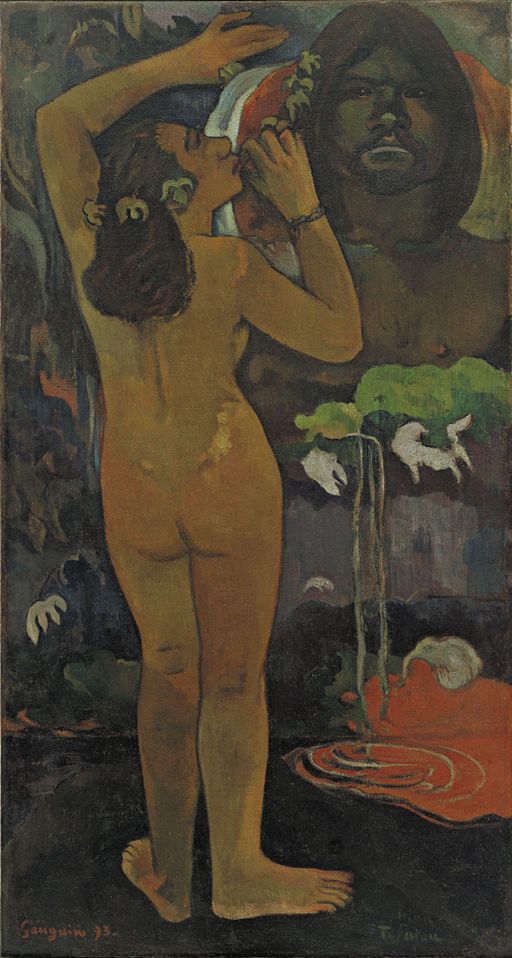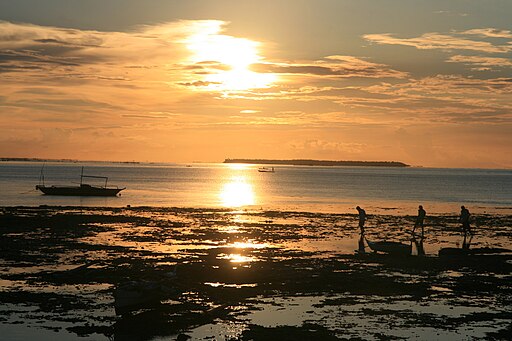Paul Gauguin (1848 – 1903) was a French post-Impressionist artist who was not appreciated until after his death. Gauguin is now recognized for his experimental use of color and a style that was distinctly different from Impressionism.
He spent the last ten years of his life in French Polynesia, and most of his paintings from this time depict people or landscapes from that region.
Gauguin’s work influenced the French avant-garde and many modern artists, such as Pablo Picasso and Henri Matisse. Gauguin’s art became famous after his death. Below is a selection of Paul Gauguin paintings of Tahitian Women.
A Tour of Paintings of Tahitian Women by Paul Gauguin
- The Dream – Courtauld Institute of Art
- Not to work – Pushkin Museum of Fine Arts
- Three Tahitians – Scottish National Gallery
- Three Tahitian Women Against a Yellow Background – Hermitage Museum
- And the Gold of their Bodies – Musée d’Orsay
- Barbarian Tales – Museum Folkwang
- The Call – Cleveland Museum of Art
- The Siesta – Metropolitan Museum of Art
- The Moon and the Earth – Museum of Modern Art
- Hail Mary – Metropolitan Museum of Art
- Two Tahitian Women With Mango Flowers – Metropolitan Museum of Art
“The Dream” by Paul Gauguin
“The Dream” by Paul Gauguin depicts two women watching over a sleeping child in a room decorated with elaborate wood reliefs.
The figures are not communicating to heightening the sense of mystery. Gauguin wrote:
“Everything is a dream in this canvas: is it the child? Is it the mother? Is it the horseman on the path? or even is it the dream of the painter!!!”
The Dream
- Title: The Dream
- Tahitian: Te rerioa
- Artist: Paul Gauguin
- Year: 1897
- Medium: Oil on canvas
- Dimensions: Height: 95.1 cm (37.4″); Width: 130.2 cm (51.2″)
- Museum: Courtauld Institute of Art
“Not to work” by Paul Gauguin

“Not to work” by Paul Gauguin
“Not to work” by Paul Gauguin depicts two young Tahitians passing the time idling in a hut smoking. Through the window, we can the artist painting outdoors.
The painting symbolizes the relaxed, natural, and contemplative lifestyle of the Tahiti islanders compared to Gauguin’s need to creat.
Not to work
- Title: Not to work
- Tahitian: Eiaha’ ohipa
- Artist: Paul Gauguin
- Year: 1896
- Medium: Oil on canvas
- Dimensions: 65 × 75 cm (25.5 × 29.5 ″)
- Museum: Pushkin Museum of Fine Arts
“Three Tahitians” by Paul Gauguin

“Three Tahitians” by Paul Gauguin
Three Tahitians by Paul Gauguin depicts three figures stand out against a vivid, colorful background. Two women flank a young man, who is seen only from behind.
The women seem to be offering him a choice between the apple and the flowers. The options are between vice and virtue.
This choice reflects the allegorical character of many of Gauguin’s Tahitian paintings. Gauguin has fused together ideas from different cultures.
Three Tahitians
- Title: Three Tahitians
- Artist: Paul Gauguin
- Year: 1899
- Medium: Oil on canvas
- Dimensions: Height: 73 cm (28.7″); Width: 94 cm (37″)
- Museum: Scottish National Gallery
“Three Tahitian Women Against a Yellow Background” by Paul Gauguin

Three Tahitian Women Against a Yellow Background
“Three Tahitian Women Against a Yellow Background” by Paul Gauguin depicts the world of the so-called “savages,” which the artist believed preserved that natural harmony which had been lost by the “civilization” of Europe.
Gauguin’s work contains unclear symbolic meanings, while at the same time, his artistic achievement of harmony of color and graceful lines have made him highly popular artist after his death.
Three Tahitian Women Against a Yellow Background
- Title: Three Tahitian Women Against a Yellow Background
- Artist: Paul Gauguin
- Year: 1899
- Medium: Oil on canvas
- Dimensions: 68 × 73.5 cm (26.7 × 28.9 ″)
- Museum: Hermitage Museum
“And the Gold of their Bodies” by Paul Gauguin

“And the Gold of their Bodies” by Paul Gauguin
“And the Gold of their Bodies” by Paul Gauguin was produced during the artist’s final years after he settled on the Marquesas Islands, in the village of Atuona.
Gauguin built a house he called his “House of Pleasure,” in search of a paradise where he could create pure, “primitive” art.
Gauguin wrote in 1885:
“There is no such thing as exaggeration in art, and I even believe that there is salvation only in extremes.”
And the Gold of Their Bodies
- Title: And the Gold of Their Bodies
- Artist: Paul Gauguin
- Year: 1901
- Medium: Oil on canvas
- Dimensions: 67 × 76 cm (26.3 × 29.9 ″)
- Museum: Musée d’Orsay
“Barbarian Tales” by Paul Gauguin

“Barbarian Tales” by Paul Gauguin
“Barbarian Tales” by Paul Gauguin is a mysterious painting, in which his past and present meet in this painting. The past is represented by the depiction of his friend Jacob Meyer de Haan, who had died in 1895.
Gauguin had painted his portrait three years earlier. Gauguin re-used this diabolic-looking image of his friend in the middle of a Tahitian landscape.
The lilies are ancient symbols of life and death. The present is represented by his favorite young Tahitian models who gaze directly at the viewer.
Barbarian Tales
- Title: Barbarian Tales
- Artist: Paul Gauguin
- Year: 1902
- Medium: Oil on canvas
- Dimensions: Height: 131.5 cm (51.7″); Width: 90.5 cm (35.6″)
- Museum: Museum Folkwang
“The Call” by Paul Gauguin

“The Call” by Paul Gauguin
“The Call” by Paul Gauguin is part of a series of the artist’s late works that explore the mysteries of life and death.
Two women stand bare feet, with one of the women gesturing to someone outside the picture. Gauguin, at this late stage in his life, was painting from memory and imagination to achieve mysterious, dreamlike images.
Paul Gauguin was preparing himself to respond to his “call” from destiny.
The Call
- Title: The Call
- Artist: Paul Gauguin
- Year: 1902
- Medium: Oil on canvas
- Dimensions: Height: 131.3 cm (51.6″); Width: 89.5 cm (35.2″)
- Museum: Cleveland Museum of Art
“The Siesta” by Paul Gauguin

“The Siesta” by Paul Gauguin
“The Siesta” by Paul Gauguin depicts the grace and communal ease of Tahitian women.
Gauguin made numerous changes to this composition that included changing the skirt of the woman in the foreground, which was initially red to the black color.
He also moved the figures in relation to each other to increase the relaxed feeling of the scene.
The Siesta
- Title: The Siesta
- Artist: Paul Gauguin
- Year: 1892 and 1894
- Medium: Oil on canvas
- Dimensions: Height: 88.9 cm (35″); Width: 116.2 cm (45.7″)
- Museum: Metropolitan Museum of Art
“The Moon and the Earth” by Paul Gauguin

“The Moon and the Earth” by Paul Gauguin
“The Moon and the Earth” by Paul Gauguin depicts an ancient Polynesian myth, in which Hina, the female spirit of the Moon, implores Fatou, the male spirit of the Earth, to grant humans eternal life. Fatou denies the request.
Hina’s figure is in full view, while Fatou, is shown from the chest up. The male spirit of the Earth is darker and more significant in the background.
The Moon and the Earth
- Title: The Moon and the Earth
- Tahitian: Hina Tefatou
- Artist: Paul Gauguin
- Year: 1893
- Medium: Oil on canvas
- Dimensions: Height: 114.3 cm (45″); Width: 62.6 cm (24.6″)
- Museum: Museum of Modern Art
“Hail Mary” by Paul Gauguin

“Hail Mary” by Paul Gauguin
“Hail Mary” by Paul Gauguin is one of the first works in his Tahitian period. The depiction shows two Polynesians greeting the Madonna and Child.
Hail Mary
- Title: Hail Mary
- Alternative title: Ave Maria
- Tahitian: Ia Orana Maria
- Artist: Paul Gauguin
- Year: 1891
- Medium: Oil on canvas
- Dimensions: Height: 113.7 cm (44.7″); Width: 87.7 cm (34.5″)
- Museum: Metropolitan Museum of Art
“Two Tahitian Women With Mango Flowers” by Paul Gauguin

“Two Tahitian Women With Mango Flowers” by Paul Gauguin
“Two Tahitian Women With Mango Flowers” by Paul Gauguin depicts two topless women, one holding mango blossoms, on the Pacific Island of Tahiti.
The two women in the painting confront the viewer with a direct gaze.
Gauguin has used an artistic tradition of comparing woman’s breasts to flowers or fruit in this painting.
Two Tahitian Women With Mango Flowers
- Title: Two Tahitian Women With Mango Flowers
- French: Deux Tahitiennes aux fleurs de mangue
- Artist: Paul Gauguin
- Year: 1899
- Medium: Oil on canvas
- Dimensions: Height: 94 cm (37″); Width: 72.4 cm (28.5″)
- Museum: Metropolitan Museum of Art
How Tahiti Transformed Gauguin’s Art
Paul Gauguin
- Artist: Paul Gauguin
- Birth Name: Eugène Henri Paul Gauguin
- Born: 1848, Paris, France
- Died: 1903 (aged 54), Atuona, Marquesas Islands, French Polynesia
- Nationality: French
- Movement: Impressionism, Post-Impressionism, Primitivism
- Notable works:
- Vision after the Sermon
- Self Portraits by Paul Gauguin
- Gauguin in front of his Easel
- Portrait of the Artist with the Yellow Christ
- Tahitian Women by Paul Gauguin
- The Dream
- Not to work
- Three Tahitians
- Three Tahitian Women Against a Yellow Background
- And the Gold of Their Bodies
- Barbarian Tales
- The Call
- The Siesta
- The Moon and the Earth
- Hail Mary
- Two Tahitian Women With Mango Flowers
France: Paul Gauguin exhibition draws charges of colonialism
Paul Gauguin’s “Woman Holding a Fruit” Captures the Exoticism and Mystique of the Tropics
Gauguin: Voyage to Tahiti
~~~
“Art is either plagiarism or revolution.”
– Paul Gauguin
~~~
Photo Credit: Paul Gauguin [Public domain]
Popular this Week








 Sponsor your Favorite Page
Sponsor your Favorite Page SEARCH Search for: Search Follow UsJoin – The JOM Membership Program
Sponsor a Masterpiece with YOUR NAME CHOICE for $5
Share this:
- Tweet
